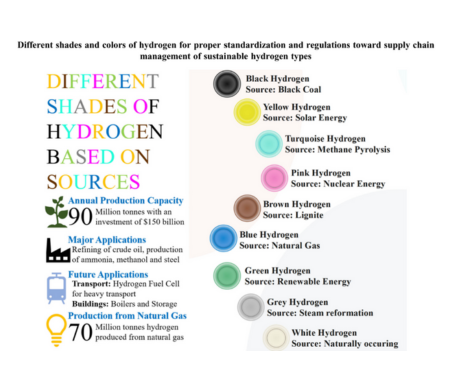Publications
Policy Implementation Roadmap, Diverse Perspectives, Challenges, and Solutions Toward Low-Carbon Hydrogen Economy
Hydrogen is a nearly emission-free energy carrier with many enticing qualities, including wide availability, environmental friendliness, and a high calorific value. There have constantly been a lot of challenges to establish an entire fledge low-carbon hydrogen (LCH) economy in the past century. This study aims to critically analyse the economic, environmental, technological, and policy implementation and division of LCH to find novel solutions, bridging the gaps and giving a perspective approach to the study. Differentiation of various LCH components, including green and blue hydrogen, was also proposed based on the life cycle assessment emissions. Current policy perspectives and promised pledged perspectives are considered to project hydrogen demand in 2030. A thorough economic analysis of LCH system technologies is also conducted from both hydrogen production and storage perspectives by comparing various production and storage systems. Current policies toward LCH were critically viewed from policymakers, consumers, and R & D perspectives, through which several challenges, gaps, and keynote necessities were also stated.


Machine Learning in
Commercialised Coatings
The major conclusive remarks noticed were the application of neural networks in the production methods. Discovery descriptors using machine learning methods on mono-layer oxide coatings and novel Li SSE and anode coatings were also discussed to see which of the machine learning approaches are beneficial based on final objectives including the artificial neural network or the linear regression methods. The main aim of this study is not only to discuss the machine learning and artificial methods but also to find sustainable production methods of coatings with net zero carbon emissions and completely substitute the traditional conventional methods into greener and advanced technology methods involving the output coatings to have commercialized layer qualities, including materials, mechanical properties, high-temperature performance, residual stress, failure processes, and life prediction methods.
Biogas and Biofuel Production from Biowaste: Modelling and Simulation Study
Due to the high levels of global energy demand, most energy is produced from fossil fuels, which account for ~88 % of the total requirements. This also results in higher levels of CO2 and other greenhouse gas emissions, thus raising the question of whether switching to renewable energy sources like biogas and biofuel production will have a less or more significant effect on the global economy. The primary reason behind the increasing success of biogas production is the low cost of available feedstocks and the wide range of biogas applications like heating, electricity, fuel, refrigeration and power generation. Some critical problems with producing biogas from various feedstocks include the enormous gap between biotech research, its commercialisation and the analysis of the future requirements of biogas in the circular economy. For biowaste generation, many lignocellulosic sources, including manure, fruit and vegetable wastes, can be employed, and anaerobic digestion can be used on a small or big scale. Several modelling and simulations are performed using the MATLAB/Simulink environment, considering hypothetical goals and future energy scenarios (calculating the number of plants operating in 2030, 2050, and so forth). These models include input-output models, Anaerobic Digestion Model 1 (ADM1), etc. There are many predictions, viewpoints, and conclusions that are discussed that claim the results of simulations of such models can lead to significant changes in the economic systems, as the use of biogas and biofuel will result in the recovery of significantly high volumes of phosphorous, to the tune of 100-150 billion euros proving the efficacy and applications of biogas and biofuels.


Low-Caron Hydrogen Economy Perspective and Net Zero-Energy Transition through Proton Exchange Membrane Electrolysis Cells (PEMECs), Anion Exchange Membranes (AEMs) and Wind for Green Hydrogen Generations
Even though there has been a rapid increase in the use of hydrogen production techniques in recent years, there is still an exigent need for affordable, sustainable and efficient low-carbon hydrogen generation methods. Based on the current United Nations Sustainable Development Goals, in recent decades, alkaline electrolysers and proton exchange membrane electrolysers have reached high commercial and industrial levels in the hydroprocessing industry. The energy generated from wind and solar energy is integrated with anion exchange membranes (AEMs) and proton exchange membrane fuel cells (PEMFCs), which produce clean hydrogen. Anion exchange membrane (AEM) electrolysers overcome the worst problems of previous types of electrolysers because of their ability to use nonplatinum and nonnafion membrane materials, high hydrogen storage density, and compact microcells recommended for large-scale low-carbon systems. Another technique for hydrogen production via oxidation is ethanol electrocatalysis in PEMECs for ultraclean hydrogen production. In this study, hydrogen production via water electrolysis with the help of anion-conducting solid polymer electrolytes and a novel integrated inorganic membrane electrode assembly (I2 MEA) for anion exchange membrane (AEM) water electrolysis by using inorganic Mg-Al layered double hydroxides (Mg-Al LDHs) as an ionic conductor were also theoretically and economically investigated for the purpose of producing low-carbon hydrogen.
Our Publication
Machine Learning in Commercialised Coatings
Biogas and Biofuel Production from Biowaste: Modelling and Simulation Study
Low-Caron Hydrogen Economy Perspective and Net Zero-Energy Transition through Proton Exchange Membrane Electrolysis Cells (PEMECs),Anion Exchange Membranes (AEMs) and Wind for Green Hydrogen Generations